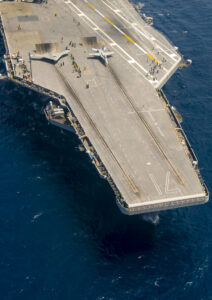
Ray Mabus
[UPDATED with Congressional reaction] ROSLYN, VA: Ray Mabus likes robots. The Navy Secretary has declared the F-35 will be “the last manned strike fighter” the service ever buys and invested heavily in unmanned aircraft, boats, and submersibles. But Mabus has frustrated drone advocates on one major program: the Unmanned Carrier-Launched Surveillance and Strike (UCLASS) aircraft.
This morning, Mabus defended the Navy’s plans for a relatively modest UCLASS optimized for the “surveillance” aspect of its mission rather than the “strike” part — but he also promised UCLASS would be “the bridge” to a future unmanned strike plane, the one that replaces F-35. Given that the F-35 will be around for decades, however, this two-stage approach is unlikely to satisfy UCLASS critics like Senate ARmed Services chairman John McCain, House Seapower chairman Rep. Randy Forbes, and key players in the Pentagon itself, all of whom want a strike drone ASAP to deal with China.
Mabus said today at a DefenseOne leadership breakfast that “I’m for a full-up penetrating strike fighter” — eventually. “We see UCLASS as getting to that,” he said — but, he made clear, not as being that.
“For UCLASS…we ought to have endurance, we ought to have range, we ought to have payload,” he said, notably omitting stealth. “It should be an ISR [intelligence, surveillance, and reconnaissance] platform, it should be a refueling platform, but it also should be a strike platform [for] uncontested or minimally contested environments.”
In the longer term, he said, “it ought to be the bridge to a full-up strike fighter — an autonomous strike fighter — that [operates] in contested environments.”

Rep. Randy Forbes
[UPDATE: “Building ‘bridges’ sounds great, but at some point you need to cross them,” Rep. Forbes snapped in an email when I asked about Mabus’s comments. “While I understand the Navy’s desire to ‘crawl, walk, and run,’ I am concerned that in the race between anti-access and power projection capabilities, we are falling further and further behind. The carrier air wing is going to need a long-range, deep penetrating strike asset, and it is going to need it soon. Given that the UCLASS program is supposed to deliver its first operational aircraft to the fleet in 2022-23, I am concerned that the program seems to be driven by the needs of today and not those of tomorrow.”
We’ve not heard from Sen. McCain, but it’s worth noting that his committee’s version of the National Defense Authorization Act adds $725 million for alternative approaches to UCLASS: $350 million to continue work with the X-47 prototypes, which the Navy had planned to retire, and $375 million for “competitive prototyping of at least two follow-on air systems that move toward a UCLASS program capable of long-range strike in a contested environment.”
Here’s the less than glowing language from the (as yet unpublished) Senate bill:
“Based on the progress to date in the ongoing Unmanned Combat Air System Demonstration program [the X-47], the committee is confident that, while additional risk-reduction and experimentation appears necessary, low- to medium-risk acquisition of advanced carrier-based, unmanned combat aircraft could be feasible in the 2020-2025 timeframe. The committee remains concerned, however, that the Navy’s current requirements for the UCLASS program place disproportionate emphasis on unrefueled endurance to support organic ISR support to the carrier strike group…The committee notes with concern that absent a restructuring of the planned carrier air wing that incorporates unmanned combat aircraft in operationally significant numbers, the relevance of the aircraft carrier — the centerpiece of American global power projection capability — may increasingly be called into question by friends and prospective adversaries alike.”

An unmanned X-47B and a manned F-18 Hornet side by side on the USS Roosevelt.
The Cyber Problem
Airspace being “contested” doesn’t just refer to enemy fighters. Indeed, the main physical threat to US aircraft is ground-based anti-aircraft missiles. But for drones in particular, which rely on some form of long-range wireless network to stay in touch with their human masters, enemy jamming or, worse yet, hacking can make an environment “contested” without firing a shot.
So like many in the Pentagon, the Navy Secretary is deeply concerned about the security of the networks that control those systems. The Navy is now waging war games to test how it should best operate under cyber attack,. Mabus said this morning, but some basic questions remain unanswered.
“One of the things we’re trying to be far more realistic about in things like wargames is, are those networks going to be there? What do you do if they’re not? How do you fight if the networks just aren’t there?” said Mabus. “One of the philosophical things that has not been answered, and it’s a really hard legal, philosophical [question], is when does a cyber attack constitute an act of war?”
(There’s a fascinating range of answers to this question, from “when it destroys a network” to “when it damages something physical” to “never.”).
“A lot of discussion’s going on,” Mabus said, “[but] there’s really been no good answer yet as to when you can have a kinetic response, when you can have a more traditional lethal response to a cyber attack. Is it when a plane goes down because somebody seized the controls in a cyber attack [or] if someone takes the [power] grid down in the US?”
“One of the main reasons that onshore that we’re moving to, No. 1, alternative energy, and No. 2, the microgrid,” Mabus added in a pitch for his favorite programs, “[is] if the grid happens to go down for whatever reason, we can get off the grid and still provide our military [power].”
Mabus’s future Navy fleet will be increasingly dependent on electrical power and networks. He’s pushed to deploy weapons like solid-state lasers and electromagnetic rail guns, which get their striking power from electricity rather than gunpowder or rocket fuel. He’s created a new deputy assistant Secretary of the Navy position specifically to keep on top of unmanned systems. And he’s championed the controversial Littoral Combat Ship, which is crewed by humans but serves as the mothership to multiple unmanned vehicles.
“Right now, the way we hunt mines is we put sailors on a minesweeper in the middle of the minefield — which is not ideal,” Mabus said. “The way LCS will fight mines, it will send an unmanned underwater vehicle in” to find the mines, followed by manned helicopters or unmanned boats to destroy them.
While he wants robots to replace people in the most dangerous jobs, Mabus took time for human matters as well this morning. After he’d touted a host of reforms meant to give naval personnel more flexibility and choice in their careers, a female officer — albeit dressed in civilian pink — stood up and asked about Mabus’s move towards gender-neutral uniforms.
“We would like to have uniforms that fit well, that look professional, but still maintain our femininity,” she said, speaking on behalf of the 1,792 members of a Facebook group for female naval officers.
“We haven’t done a very good job of making sure uniforms fit either men or women,” Mabus admitted. “[But] I think wearing different uniforms has segregated women, sometimes in not good ways.”
“The word uniform means the same,” the secretary pointed out. “The whole goal about uniforms and uniformity….is that, when you look out over a group of sailors, you don’t see male sailors and female sailors, you see United States sailors.”
Air Force’s legislative proposal is an existential threat to the National Guard
In this op-ed, Francis M. McGinn, the head of the National Guard Association, blasts an Air Force proposal to transfer National Guard units performing space missions to the Space Force.


























